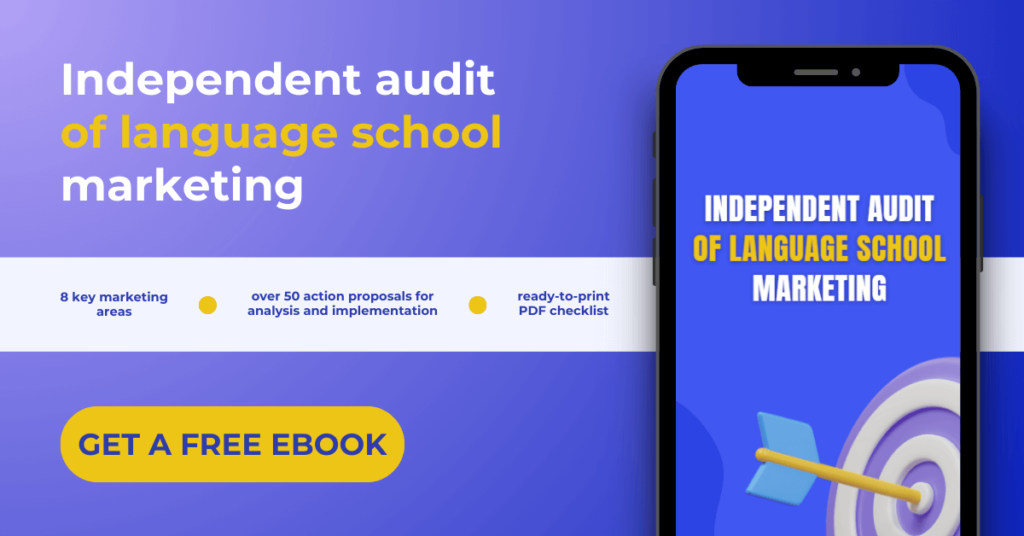
Today, every company, from language schools to small clothing stores, is shaping its online image. Social media is not just a platform for communicating with customers, but also a tool for gathering feedback and building relationships. What are the key elements, and how can you conduct marketing on social media?
Discover how to execute activities across numerous social media platforms to gain an advantage and capture the attention of your audience.
What will you find in this article?
- What is social media marketing?
- Who should opt for social media marketing?
- How does social media marketing work?
- Which platforms to use for effective social media marketing?
- Step-by-step social media marketing in language school
- Summary – how to conduct social media marketing in language school?
What is social media marketing?
Social media marketing is the process of building brand presence and audience engagement on platforms such as Facebook, Instagram, TikTok, and LinkedIn.
Through strategic content publishing, user interactions, and performance analysis, companies build their image, acquire new customers and increase loyalty.
Who should opt for social media marketing?
In today’s digital world, social media marketing is an essential component for any company, regardless of industry or size. Social media provides access to a broad audience, enables gathering customer feedback, and creates an authentic connection with the audience.
Through social media, your company can reach new clients, strengthen relationships with current ones, and effectively develop its brand image.

How does social media marketing work?
There is no single, universal approach to social media marketing that guarantees success. However, there are elements that are effective across all industries.
The most important one is that social media are primarily platforms for building relationships with current and potential clients. It’s a place where you create positive experiences, build trust, develop a professional image, and showcase the everyday life of your company.
Social media are tools that support sales—their main goal is to build connections and trust.
Which platforms to use for effective social media marketing?
The choice of the right social media platforms depends on the target audience of your business. For example, if your target group consists of teenagers, focus on Instagram and TikTok, which are popular among this age group (according to a Piper Sandler study).
If your audience includes professionals, consider LinkedIn. The key is to tailor content to the specifics of a given platform and the needs of your clients.
You can find more information on how to effectively conduct activities on individual platforms in separate articles on our blog:
✔︎ Language school’s Instagram – step-by-step guide
✔︎ 10 tricks for an effective Facebook fanpage of a language school
✔︎ LinkedIn for language schools: a complete guide
Step-by-step social media marketing in language school
We present the key elements that will help you conduct effective marketing on social media.
Use the following tips to build a strong online presence for your school and engage your community.

Understand your target audience
The first step to effective marketing is knowing your target audience: who they are, what they are interested in, and what they expect from your company. Clearly define communication goals – these may include increasing website traffic, building brand awareness, or fostering positive relationships.
It’s worth monitoring how many users actively engage with content, comment, and provide honest feedback.
Choose the right tone and communication channel
Knowing your target audience makes it easier to adjust the style of posts, tone of communication, and platforms you publish on. Younger generations prefer more dynamic, visual content on platforms like Instagram and TikTok.
The content must be valuable, easy to digest, meet customer needs, and solve their problems.
Create engaging and valuable content
Social media users browse content quickly, so you have only a few seconds to capture their attention. Effective content is one that immediately intrigues the audience while addressing their needs. Create content that is both visually appealing and valuable – this is the key to attracting attention.
Also, focus on more relaxed content, which often achieves greater reach and more effectively engages the audience. A perfect example is Real Time Marketing, which includes marketing activities that refer to current events. The best results come from content embedded in context and tailored to your industry.
Combining valuable, substantive content with more relaxed, current posts creates content that not only grabs attention but also strengthens loyalty and engagement among your audience.
Publish regularly
Consistency is crucial in building engagement. Plan a publication schedule that will maintain your audience’s activity and interest. It’s worth experimenting with the frequency of posts and publication times to determine what works best for your target group.
Engage with your audience
Interacting with your audience is key to building lasting relationships. Respond to comments, ask questions in posts, and encourage conversations and feedback.
This shows that the company is open to feedback and values the opinions of its clients.
Consider paid advertising
In addition to organic activities, it’s worth considering paid advertisements, which allow you to reach a larger audience. With precise targeting, you can direct your ads to selected groups, increasing the chances of effectively reaching potential clients.
Analyze actions and optimize strategy
Monitor the effects of your actions using analytical tools available on platforms.
Analysis helps understand which content attracts the most attention, what are the best days and times for publication, and how to improve the strategy to achieve better results.
Summary – how to conduct social media marketing in language school?
Social media marketing is based on several key pillars, such as understanding your target audience, selecting appropriate channels and tone of communication, regular publications of valuable and engaging content, and utilizing paid advertisements.
It’s a dynamic and continuous process that requires not only analysis and optimization but also building authentic relationships with your audience. In a world full of information and advertisements, it’s important to stand out and reach potential students in an effective and engaging way.

